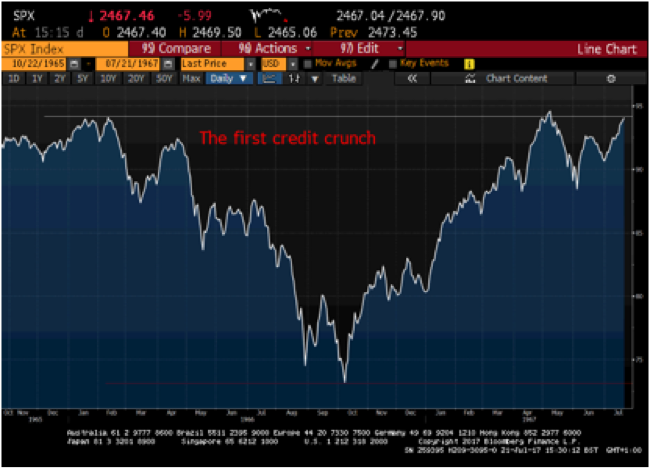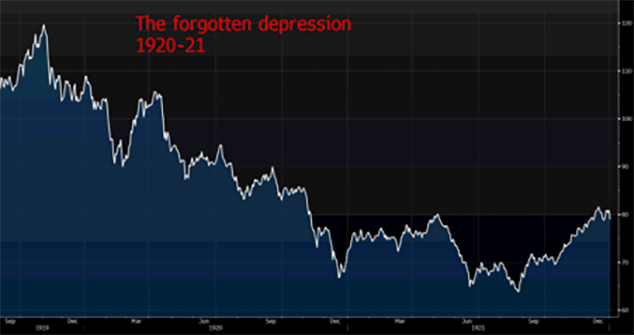How the credit crunch of 1966 set the tone for central banks
John Stepek looks back at the 1966 credit crunch – the first important financial crisis of the post-war period, which set an unhealthy pattern for the future.

I thought we'd dig into a bit of financial history this morning.This is the first in an occasional series I'll be running once a week or so.
Specifically, given today's interesting and slightly precarious-feeling environment, I want to delve into periods where it's all gone pear-shaped in the past.
Today we'll look at the first post-war "credit crunch" the crisis of 1966.
MoneyWeek
Subscribe to MoneyWeek today and get your first six magazine issues absolutely FREE

Sign up to Money Morning
Don't miss the latest investment and personal finances news, market analysis, plus money-saving tips with our free twice-daily newsletter
Don't miss the latest investment and personal finances news, market analysis, plus money-saving tips with our free twice-daily newsletter
What do you mean, you've never heard of it? Nor had I, I'll admit, until very recently.
Prepare to be enlightened...
The forgotten credit crunch
In 1966, the US economy was booming. Unemployment was running at just 4%, even lower than it is today.Companies were operating at full capacity and, expecting more growth, were ramping up investment.
Lyndon B Johnson was president. America was knee-deep and getting deeper in the war in Vietnam (the top-selling single in America that year was The Ballad of the Green Berets, by Staff Sergeant Barry Sadler, a Special Forces medic). As a result, the government was spending hard too.
In short, the economy was running hot.
The S&P 500 index hit its high for the year on 9 February it closed at the whopping heights of 94. It then lost 22% over the following eight months, bottoming out at just below 75 on 7 October. The real damage was done during the summer months, as the Bloomberg chart below shows.

You're probably starting to see why this isn't one of the more famous crashes. The S&P managed to lose almost that much in a single session on Black Monday in October 1987.
But 1966 is worth looking at. Not only is it widely recognised by economists as the first important financial crisis of the post-war period, it also set an unhealthy pattern for future financial crises.
Here's how it all unfolded.
Financial tech + clumsy regulation + sneaky banks = crisis
One of the many interesting things about looking at the history of financial crises is that you start to notice the way that the interplay of financial technology and outdated regulatory systems and banking ingenuity (or sneakiness) combine to create fresh blow-ups.
In the case of 1966, the new financial technology was the negotiable certificate of deposit. This was introduced in 1962. In effect, it allowed banks to offer better interest rates to savers.This in turn, meant that they took in more funds.
They used this money to buy high-yielding bonds (such as municipal bonds loans to local government) and to lend out to customers. It's the old 3-6-3 recipe for happy banking "pay savers 3%, charge borrowers 6%, hit the golf course at 3pm".
As a result of all this, the banks had more money to lend out. And it turned out that when money was available, people wanted to borrow it. As economist and analyst Albert M Wojnilower wrote in his 1980 Brooking Institute paper, The Central Role of Credit Crunches in Recent Financial History, this "new approach revealed an enormous pent up credit demand".
Bank lending boomed, growing at an annual rate of 13%-plus over the four years from 1962 to 1966. Unsurprisingly, inflation started to pick up too. During the early 1960s, inflation was extremely well behaved. But in the first nine months of 1966, consumer price inflation picked up from 1.7% to 3.7% in 1965.
As a result of this rising inflation, the Fed funds rate was steadily being raised too from below 2% in 1961 to 5.75% in 1966. And that's where the problem arose.
Alongside all the familiar levers the Fed could use to intervene in markets, there was a rule known as "Regulation Q". This put a ceiling on interest rates that banks could offer to savers.
The ceiling was set by the Fed at 5.5%. That was fine in the early 1960s. But as inflation rose and interest rates on other assets rose along with it, the yield available on other safe assets such as three-month Treasury bonds outstripped the rate that the banks could offer to savers.
By summer 1966, banks couldn't compete. Savers stopped putting their money into the banks and put it into other "higher-yielding conservative investments", notes Alex Pollock of RealClearMarkets.
Without any money to lend, as The New York Times reported, bank lending dried up. "For most people, residential mortgage money was unobtainable... there was a sharp slump in mortgage loans and housing starts." (Even then, the property market was paramount).
And as well as cutting lending, banks stopped investing particularly in municipal bonds. That was bad news for the "muni" market, and for local councils that needed the funds.As Albert E Burger of the St Louis Fed noted in his 1969 analysis of the "crunch", the banks were big buyers of these bonds. "In 1960 commercial banks had about 7.5 cents of every deposit dollar invested in municipals. By mid-1965 banks' municipal portfolios accounted for almost 12 cents of every deposit dollar."
As a result, "by the end of August,the disorganisation in the municipals market, rumours about the solvency and liquidity of savings institutions, and the frantic [funding] efforts by money-centre banks generated what can be characterised as a controlled panic," noted economist Hyman Minsky.
What happened? The Fed freaked out and came to the rescue, of course.In early September, banks were allowed to borrow direct from the Fed's "discount window". But only as long as they reduced lending to businesses and kept investing in munis. The muni market stabilised and stocks bottomed out, even as a shaken Fed cut interest rates sharply.
Why was there no recession? Partly because the Fed changed its tune pretty quickly. But mainly because government spending on the war in Vietnam kept ramping up. This offset the significant drop in corporate investment as banks reined in corporate lending.
The birth of the "Greenspan put"
Given the limited immediate consequences, and the sheer mess of the decade that followed, it's no surprise that the crisis of 1966 isn't exactly etched into anyone's memory. What's most interesting about the whole thing from an investment point of view, is that it set a pattern for the future.
As Minsky scholar L. Randall Wray puts it in a piece for the Jerome Levy Economics Institute, "as a result of Fed intervention, the economy continued to expand, new financial practices emerged and were validated, leverage ratios increased, memories of the Great Depression faded, and markets came to expect that big government and the Fed would come to the rescue as needed."
In short, Alan Greenspan might have made the "Greenspan put" infamous but the moral hazard created by the Fed's actions was already becoming embedded in markets while he was still playing jazz clarinet and hanging out with his fellow Ayn Rand disciples.
Get the latest financial news, insights and expert analysis from our award-winning MoneyWeek team, to help you understand what really matters when it comes to your finances.
John Stepek is a senior reporter at Bloomberg News and a former editor of MoneyWeek magazine. He graduated from Strathclyde University with a degree in psychology in 1996 and has always been fascinated by the gap between the way the market works in theory and the way it works in practice, and by how our deep-rooted instincts work against our best interests as investors.
He started out in journalism by writing articles about the specific business challenges facing family firms. In 2003, he took a job on the finance desk of Teletext, where he spent two years covering the markets and breaking financial news.
His work has been published in Families in Business, Shares magazine, Spear's Magazine, The Sunday Times, and The Spectator among others. He has also appeared as an expert commentator on BBC Radio 4's Today programme, BBC Radio Scotland, Newsnight, Daily Politics and Bloomberg. His first book, on contrarian investing, The Sceptical Investor, was released in March 2019. You can follow John on Twitter at @john_stepek.
-
 High earners face £15k income hit by 2029 following Autumn Budget
High earners face £15k income hit by 2029 following Autumn BudgetRachel Reeves’s Autumn Budget means high earners – or HENRYs – are now looking at an income hit running into the thousands. Can you avoid it?
-
 Millions underestimate how many paydays are left until retirement - why you should be counting your payslips
Millions underestimate how many paydays are left until retirement - why you should be counting your payslipsKeeping track of how long you will be earning a salary for can help work out how much you need to put into a workplace pension
-
How Britain avoided the worst of the Great Depression
Features For Britain, the Great Depression really wasn’t especially great, or particularly depressing. John Stepek explains why.
-
How America's roaring ’20s paved the way for the Great Depression
Features In the latest in his series on history’s greatest market crashes, John Stepek looks at the Roaring ’20s, and how the US went from a booming stockmarket to the Great Depression.
-
How the tulip mania of 1636 became the mother of all bubbles
Features John Stepek looks at what really happened in the Dutch tulip mania of the 17th century, and asks what it can tell us about the financial system today.
-
A classic stockmarket horror story for October: the Panic of 1907
Features In the latest of his articles on history’s great financial disasters, John Stepek looks at what the Panic of 1907 can tell us about today’s markets.
-
What we can learn from the bond market crash of the late 1960s
Features John Stepek casts an eye back to the slow, painful bond market crash of 1967-71 to see what investors can learn about the current bond bubble.
-
What caused the stockmarket crash of 1987 – and could it happen again today?
Features The 1987 stockmarket crash was a surprise for many – but some did see it coming. John Stepek explains what caused it, and what it tells us about today’s markets.
-
 The depression you've probably never heard of
The depression you've probably never heard ofFeatures The 1920/21 depression was a whopper, with US stocks falling by almost 50%. But now, it’s all but forgotten. John Stepek asks what we can learn from it.
